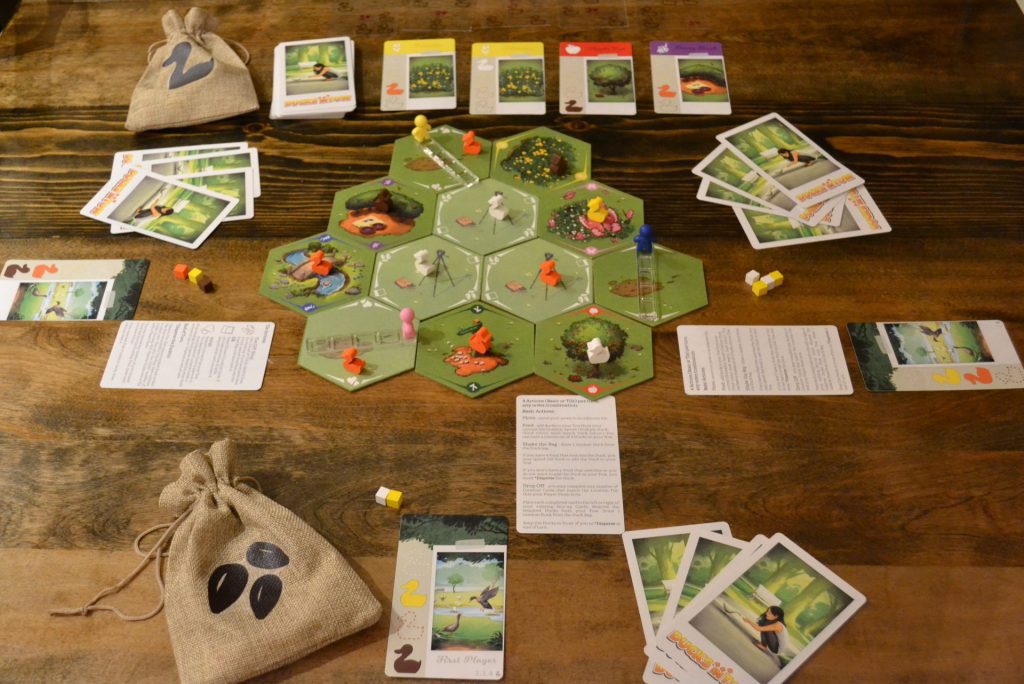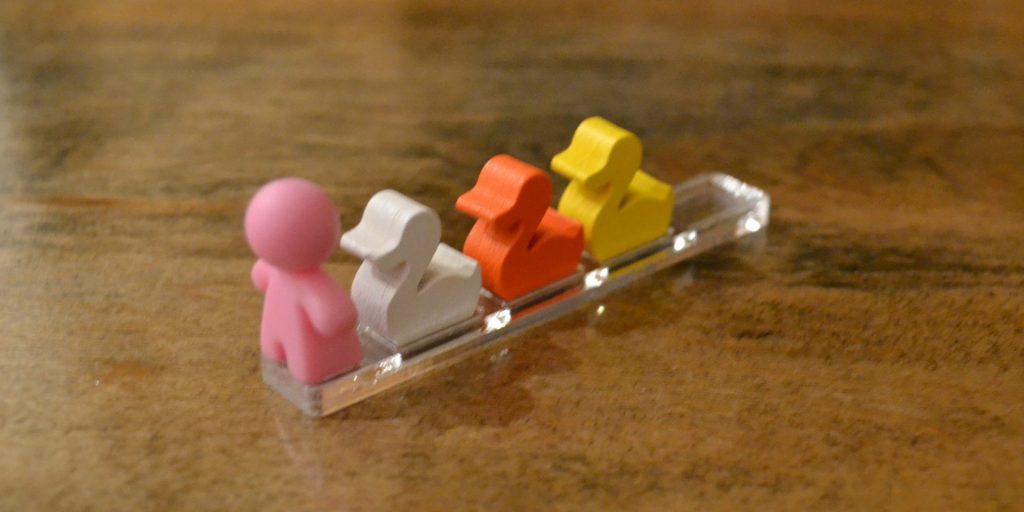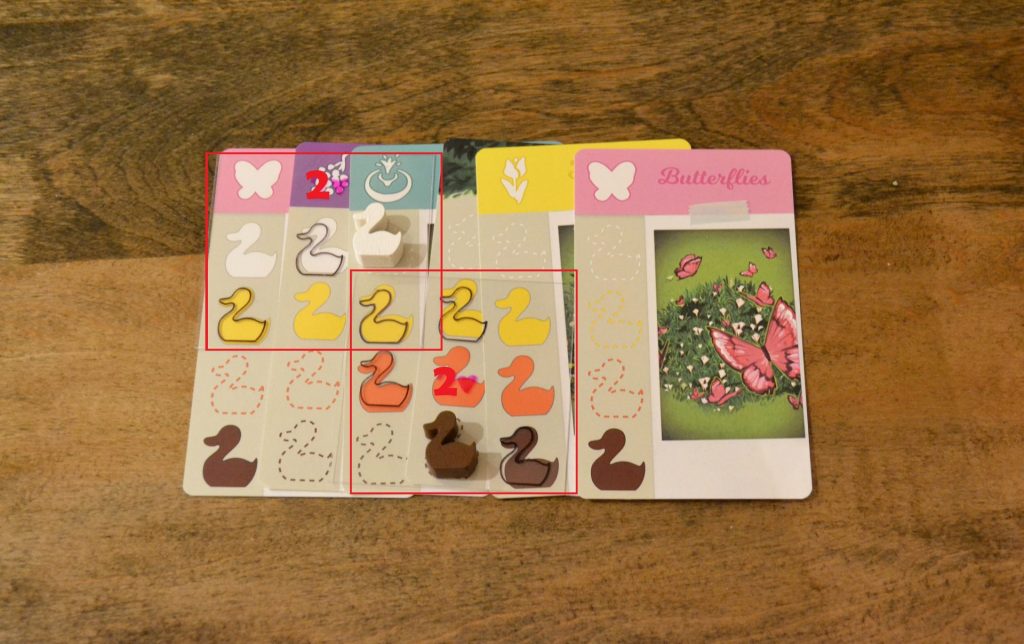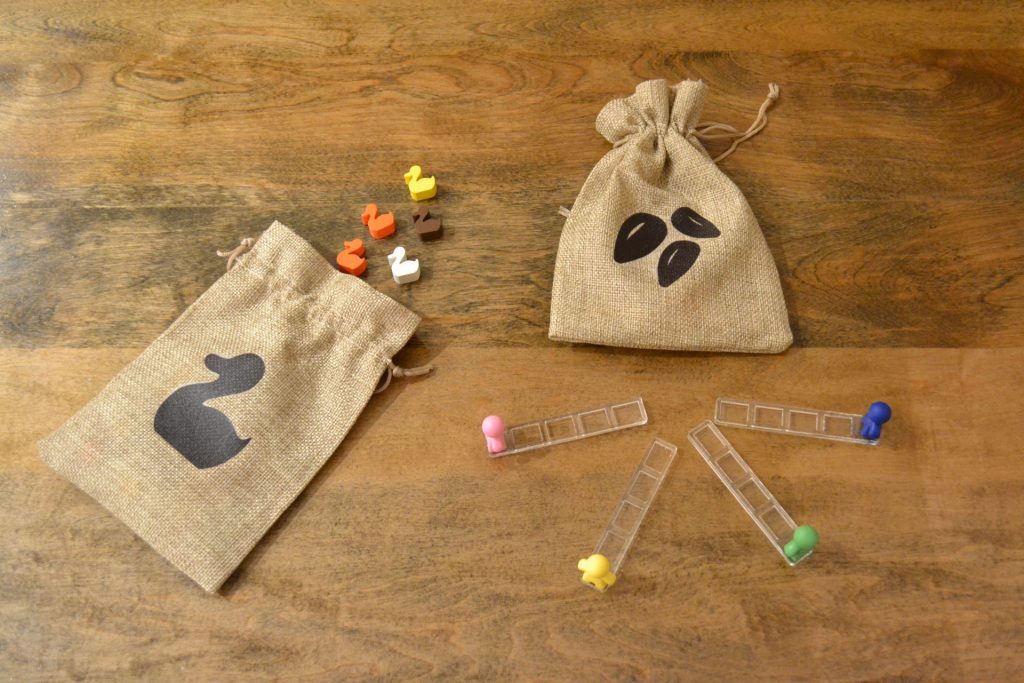Disclosure: Meeple Mountain received a free copy of this product in exchange for an honest, unbiased review. This review is not intended to be an endorsement.
I was originally drawn to Ducks in Tow because of its cute theme. In this game players feed ducks and then escort them to their favourite spot in a park where they snap a photo with them before sending them on their way. Mechanically, it’s a pick-up and deliver game. Thematically, it’s unique and adorable.
I was also drawn to the game because of the fact that it was designed by a woman, something that’s still too uncommon for board games (unless they’re about birds). It’s always nice to see women flying to new heights in a male-dominated industry.

Playing the Game
In Ducks in Tow, players will be moving around the board, adding ducks to their tow (pictured below) and using these ducks to fulfill secret objective cards that they have in their hand. To do this, a player gets to take four actions on their turn. There are two kinds of actions — Basic or Tile — and players can do any number of them in any combination.

Basic Actions:
- Feed: get ducks to follow you around the park by giving them food matching their colour. You can feed any number of ducks on a space as one action so long as you have the correct food. However, you can only ever have four ducks in tow, so even if you have the right food you may not want to feed all the ducks.
- Shake the Bag: if you don’t want to move but you really want a duck of a specific colour you can do this action to randomly draw a duck from the bag. If it’s the duck you wanted and you have the correct food you can add it to your tow. Otherwise, it will wait in front of you to join its friends on the board at the end of your turn.
- Move: move your piece (with your ducks in tow) to any adjacent space.
- Drop Off: if you have the correct ducks in tow and you are at their desired location, you can deliver ducks. Take a selfie with them and then set them free. You can fulfill as many Location Cards as you can meet in one action, but each duck can only count towards one Location Card.

Tile Actions:
The last two possible actions are “Tile Actions” and can only be performed on the corresponding tiles. They are:
- Adopt: if you have more than one duck in tow, you can adopt one! This duck is removed from play and placed in your scoring area. Offended that you didn’t pick it, the other duck leaves your tow and is dispersed at the end of your turn.
- Gift Shop: either take two food of your choice or two new Location Cards. In both cases the maximum you can have is four so you must discard down at the end of this action if you have more than four.
Turn End
After a player has completed their four actions they do the following:
- Disperse Ducks: any ducks that gathered in front of you during your turn from the Drop Off and Adopt actions will be dispersed at the end of your turn. To do this you select tiles one at a time and place a random duck there. You do this until all the ducks in front of you are on the board.
- Draw Food: you always draw back up to four food at the end of your turn. If you don’t like the food you have in your hand you may discard any number before drawing.
- Draw Location Cards: D=draw Location Cards from the face-up market or from the face-down stack until you have 4 cards in your hand.
Scoring Points?
Players score points based on the Location Cards they fulfilled and the ducks they adopted. At the beginning of the game, each player will start with one card in front of them. After each Drop Off action, they will add cards to either end of their row of cards, much like creating a route in Thurn and Taxis. These cards cannot be rearranged. This is important because players will score points based on how many ducks they have in a row. Each colour of duck scores based on how many are in a continuous row.

During the game you can also score points by completing Formation Cards. A Formation Card is a pattern of ducks in your tableau of Location Cards. If you have this pattern after doing a Drop Off or Adopt action, you can claim a Formation Card. The number of Formation Cards in a game is player count plus 2. This is important because the end of the game is triggered by the last Formation Card being claimed.

The other way that the game can end is by Location Cards. When a player collects their 6th Location Card in a 4-player game (7th in a 3-player game, or 8th in a 2-player game) the game end is triggered. When the game end is triggered, each player (including the triggering player) gets one last turn.
Final Thoughts
Ducks in Tow reminds me of both Splendor and Takenoko; for a light-strategy game this is pretty high praise. The Formation Cards are similar to the nobles in Splendor, and the board interaction and secret objectives remind me of Takenoko. Not to say that the game isn’t unique; it certainly is. My point is just that if you enjoy these games, I think you’ll probably like Ducks in Tow as well.
The simplicity of the setup and gameplay means that the rulebook is short and easy to read. It’s also organized well so it’s easy to quickly reference if you have a question. Not that you’d need to, because the game comes with very comprehensive player aids. The only thing that could improve these player aids is if the steps at the end of a player’s turn were numbered. This would make it easier to quickly reference what step comes first.

The components of this game are great; I love that each player piece has the perfect spot for each duck they have in tow. The burlap bags for ducks and food are attractive and functional; a very nice touch. Finally, there are duck meeples! I think that says enough. My only complaints are very minor: sometimes the ducks fall off of the player piece when they’re moved, and the box is quite a bit larger than it needs to be (a pet-peeve of mine). These things could easily be fixed, and may well be since Ducks in Tow is live on Kickstarter now. Even with these minor flaws, I’m quite pleased. I’m a sucker for good components and, if the Kickstarter copies are the same quality as the copy I received, I’m pretty sure no one will be disappointed with them.

As a final note for my sanity, I will mention to anyone inspired by this game’s adorable theme that if you want to feed ducks, please don’t feed them bread. In fact, it’s best to just leave them alone and get your duck feeding thrills from Ducks in Tow. It won’t disappoint!
Six Month Update
I’ve played this a few times since the review. It’s a great length for a game over lunch at work. I’ve taught it to a few players, and they picked up the rules quite quick. I’m sticking with my view that this is a lovely light strategy game.











Add Comment